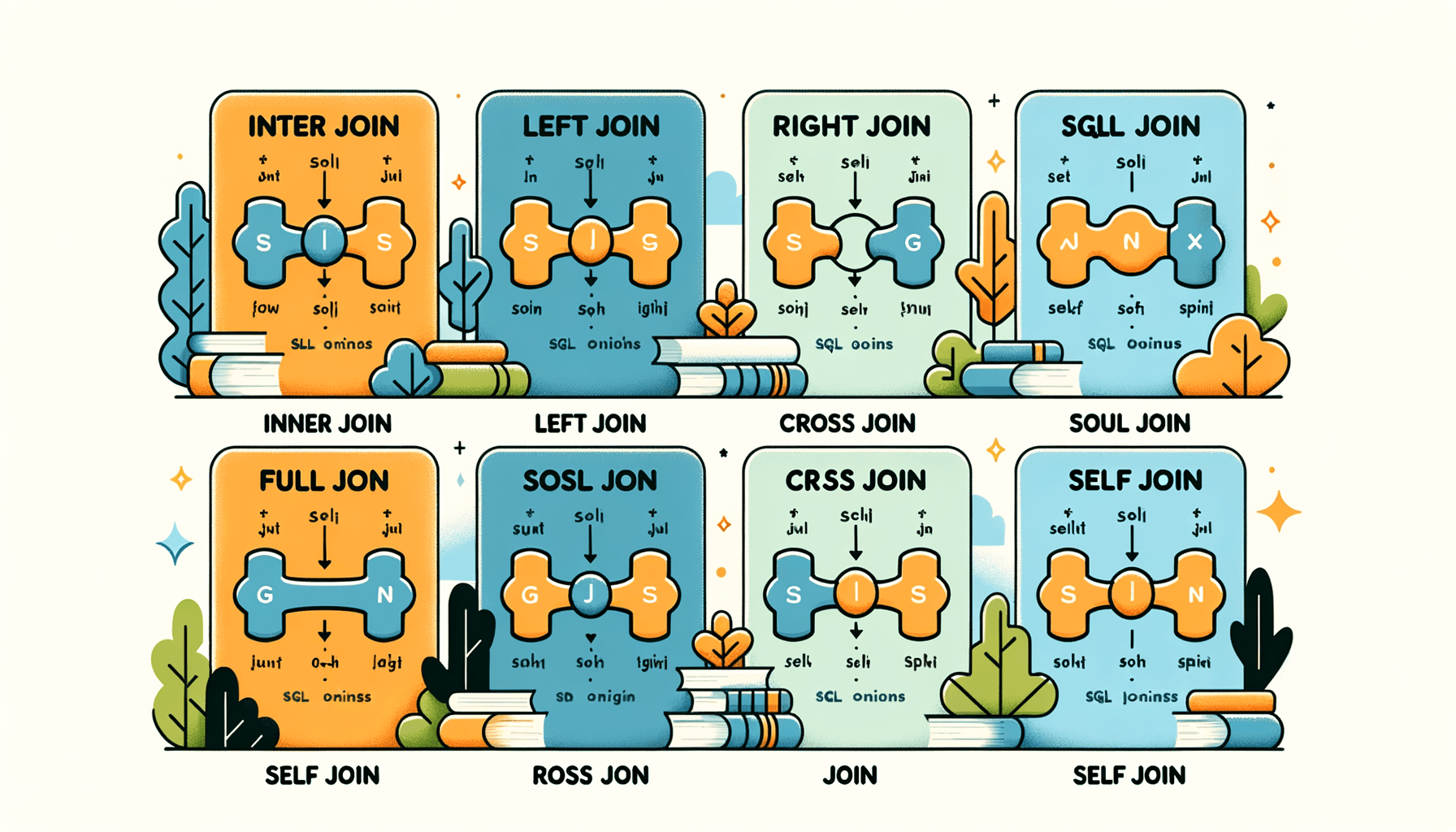A big variety of articles and resources

Mastering SQL Joins: A Comprehensive Guide for Beginners
 Sia Author and Instructor
Learn SQL
Sia Author and Instructor
Learn SQL
15 minute read
SQL joins are essential tools for anyone working with databases. They help you combine data from different tables, making it easier to analyze and retrieve meaningful information. This guide will break down the various types of SQL joins, explain their uses, and provide practical examples to help you master them.
Key Takeaways
- SQL joins are crucial for combining data from multiple tables.
- Inner joins return only matching rows from the joined tables.
- Left joins include all rows from the left table, even if there are no matches in the right table.
- Right joins are similar to left joins but include all rows from the right table.
- Full outer joins merge all data from both tables, including non-matching rows.
Understanding the Basics of SQL Joins
Definition and Importance
SQL joins are essential tools for combining data from multiple tables in a relational database. They allow you to link tables based on related columns, making it easier to retrieve meaningful information. Mastering SQL joins is crucial for effective database management and data analysis.
Types of SQL Joins
There are several types of SQL joins, each serving a different purpose:
- Inner Join: Returns only the rows with matching values in both tables.
- Left Join: Returns all rows from the left table and the matched rows from the right table. If no match is found, NULL values are returned for columns from the right table.
- Right Join: Similar to Left Join, but returns all rows from the right table and the matched rows from the left table.
- Full Outer Join: Returns all rows when there is a match in one of the tables. If there is no match, NULL values are returned for columns from the table without a match.
- Cross Join: Returns the Cartesian product of the two tables, meaning it combines all rows from the first table with all rows from the second table.
- Self Join: A table is joined with itself to compare rows within the same table.
Syntax and Structure
The basic syntax for an SQL join is as follows:
SELECT columns FROM table1 JOIN_TYPE table2 ON table1.column = table2.column;
Here's a breakdown of the syntax:
- SELECT columns: Specifies the columns to retrieve.
- FROM table1: Specifies the first table.
- JOIN_TYPE table2: Specifies the type of join and the second table.
- ON table1.column = table2.column: Specifies the condition for the join, usually a common column between the tables.
Understanding these concepts is crucial for linking tables, maintaining data integrity, and optimizing database performance.
Inner Joins: Combining Data from Multiple Tables
Concept of Inner Joins
Inner Joins are used to combine rows from two or more tables based on a related column between them. This type of join returns only the rows where there is a match in both tables. It's the most common type of join and is essential for querying relational databases.
Use Cases and Examples
Inner Joins are particularly useful when you need to find records that have corresponding entries in another table. For example, if you have a customers table and an orders table, you can use an Inner Join to find all customers who have placed orders.
SELECT customers.name, orders.order_id FROM customers INNER JOIN orders ON customers.customer_id = orders.customer_id;
Performance Considerations
While Inner Joins are powerful, they can be resource-intensive, especially with large datasets. It's crucial to ensure that the columns used for joining are indexed to improve performance. Additionally, be mindful of the query execution plan to avoid unnecessary computations.
Inner Joins are a fundamental tool in SQL, enabling you to combine data from multiple tables efficiently. However, always consider the performance implications and optimize your queries accordingly.
Left Joins: Including Non-Matching Rows
Concept of Left Joins
A Left Join is a type of SQL join that returns all records from the left table and the matched records from the right table. If there is no match, the result is NULL from the right side. This join is useful when you want to include all entries from the left table, even if there are no corresponding matches in the right table.
Practical Applications
Left Joins are particularly useful in scenarios where you need to find records in one table that do not have corresponding entries in another table. For example, you might want to list all customers and their orders, including those customers who have not placed any orders.
Handling Null Values
When using Left Joins, you will often encounter NULL values in the result set. These NULL values indicate that there was no matching record in the right table. Handling these NULL values properly is crucial for accurate data analysis. You can use functions like COALESCE to replace NULL values with default values.
Left Joins are essential for comprehensive data analysis, ensuring that no data is left out, even if it doesn't have a match in the related table.
Right Joins: A Mirror Image of Left Joins
Concept of Right Joins
A Right Join in SQL is similar to a Left Join, but it includes all rows from the right table and the matching rows from the left table. If there is no match, the result is NULL on the side of the left table. This join is useful when you need to keep all records from the right table.
Use Cases and Examples
Right Joins are often used when you want to ensure that all data from the right table is included in your results, even if there are no corresponding matches in the left table. For example, if you have a table of employees and a table of departments, and you want to list all departments regardless of whether they have employees, a Right Join would be appropriate.
SELECT departments.name, employees.name FROM employees RIGHT JOIN departments ON employees.department_id = departments.id;
Performance Implications
Right Joins can be less efficient than Inner Joins because they need to include all rows from the right table, even those without matches in the left table. Optimizing your database and indexing can help mitigate some of these performance issues. Always consider the size of your tables and the necessity of including non-matching rows when deciding to use a Right Join.
When working with large datasets, it's crucial to understand the performance implications of different types of joins. Right Joins, while useful, can sometimes lead to slower query performance if not used judiciously.
Mastering these joins is essential for data analysis and application development.
Full Outer Joins: Merging All Data
Concept of Full Outer Joins
A Full Outer Join is a type of SQL join that returns all records when there is a match in either left (table1) or right (table2) table records. If there is no match, the result is NULL on the side that does not have a match. This join is useful when you need to combine all data from two tables, including unmatched rows.
Practical Scenarios
Full Outer Joins are particularly useful in scenarios where you need a complete dataset from two tables, even if some rows do not have corresponding matches. For example:
- Merging customer data from two different regions.
- Combining sales records from two different years.
- Integrating data from two different departments.
Performance and Optimization
Using Full Outer Joins can be resource-intensive, especially with large datasets. Here are some tips to optimize performance:
- Indexing: Ensure that the columns used in the join condition are indexed.
- Filtering: Apply filters to reduce the number of rows before performing the join.
- Hardware: Use adequate hardware resources to handle the increased load.
Full Outer Joins can be powerful but should be used judiciously to avoid performance bottlenecks. Always test and optimize your queries to ensure they run efficiently.
Cross Joins: Cartesian Product of Tables
Concept of Cross Joins
A Cross Join, also known as a Cartesian Join, is a type of SQL join that returns the Cartesian product of two tables. This means that it combines each row from the first table with every row from the second table. Cross Joins can result in a large number of rows if the tables involved are large.
Use Cases and Examples
Cross Joins are useful when you need to generate combinations of data. For example, if you have a table of products and a table of stores, a Cross Join can help you list all possible combinations of products and stores.
Here is a simple example:
SELECT * FROM Products CROSS JOIN Stores;
This query will return every possible combination of products and stores.
Performance Considerations
While Cross Joins can be powerful, they can also be resource-intensive. The number of rows in the result set is the product of the number of rows in the two tables. Therefore, it's important to use Cross Joins judiciously, especially with large tables, to avoid performance issues.
When working with Cross Joins, always consider the size of your tables to prevent excessive resource consumption.
By understanding and using Cross Joins effectively, you can master data relationships and enhance your SQL skills.
Self Joins: Joining a Table with Itself
Concept of Self Joins
A self join is a regular join, but the table is joined with itself. This is useful when you need to compare rows within the same table. Self joins are often used to find relationships within a single table. For example, you might use a self join to find employees who report to the same manager.
Practical Applications
Self joins can be applied in various scenarios, such as:
- Finding hierarchical data, like organizational structures.
- Comparing rows within the same table to find duplicates or patterns.
- Analyzing time series data by comparing different time periods.
Common Pitfalls
When using self joins, it's easy to make mistakes. Here are some common pitfalls to avoid:
- Ambiguous Column Names: Always use table aliases to avoid confusion.
- Performance Issues: Self joins can be resource-intensive, so optimize your queries.
- Incorrect Join Conditions: Double-check your join conditions to ensure they are correct.
Self joins are powerful but can be tricky. Always test your queries thoroughly to ensure they return the expected results.
Advanced Join Techniques
Using Subqueries with Joins
Subqueries can be used within joins to create more complex queries. They allow you to filter data in a more refined way. For example, you can use a subquery to find the maximum value in a column and then join it with another table to get related data.
Combining Multiple Joins
Sometimes, you need to combine multiple joins to get the desired result. This can involve using inner joins, left joins, and right joins in a single query. Combining multiple joins can help you gather comprehensive data from various tables.
Optimizing Join Performance
Performance is crucial when dealing with large datasets. Here are some tips to optimize join performance:
- Use indexes on columns that are frequently joined.
- Avoid using functions on columns in the join condition.
- Use the smallest dataset possible for joins.
Optimizing join performance can significantly speed up your queries and improve overall database efficiency.
Common Mistakes and How to Avoid Them
Misunderstanding Join Types
One of the most frequent mistakes is misunderstanding the different types of joins. Each join type serves a unique purpose, and using the wrong one can lead to incorrect data retrieval. For example, using an INNER JOIN when a LEFT JOIN is needed can exclude important data. Always double-check the join type to ensure it matches your data needs.
Incorrect Join Conditions
Another common error is setting incorrect join conditions. This can result in either too many or too few rows being returned. Make sure your join conditions accurately reflect the relationships between your tables. For instance, if you're joining tables on a non-unique column, you might end up with a Cartesian product, which is usually not what you want.
Performance Issues
Performance can be a significant concern when working with joins. Poorly optimized queries can slow down your database. To avoid this, always consider the performance implications of your joins. Use indexes wisely and avoid joining large tables unnecessarily. Regularly review and optimize your queries to maintain efficiency.
Regular review and optimization of SQL queries are recommended for efficiency and accuracy.
Practical Exercises and Real-World Scenarios
Hands-On Practice
To truly master SQL joins, you need to practice with real data. Hands-on practice is essential for understanding how joins work in different scenarios. Start by creating your own sample databases and tables. Then, write queries to join these tables in various ways. This will help you see the results and understand the impact of each type of join.
Case Studies
Case studies are a great way to learn how SQL joins are used in real-world applications. For example, consider a retail business that needs to combine customer data with purchase history. By studying such cases, you can learn how to apply joins to solve complex business problems. Analyzing case studies will also help you understand the importance of mastering joins for precise data retrieval.
Best Practices
When working with SQL joins, it's important to follow best practices to ensure efficient and accurate results. Here are some tips:
- Always use clear and descriptive table aliases.
- Avoid using SELECT *; specify the columns you need.
- Use INNER JOIN when you only need matching rows from both tables.
- Use LEFT JOIN to include all rows from the left table, even if there are no matches in the right table.
- Optimize your queries by indexing the columns used in joins.
Practicing these best practices will not only improve your SQL skills but also make your queries more efficient and easier to understand.
By engaging in practical exercises and studying real-world scenarios, you'll gain the confidence and skills needed to use SQL joins effectively in any situation.
Tools and Resources for Mastering SQL Joins
Recommended Software
To master SQL joins, it's essential to use the right software. SQL databases like MySQL, PostgreSQL, and SQL Server are great for practice. These platforms offer robust environments to test and refine your skills.
Online Tutorials and Courses
There are numerous online resources to help you learn SQL joins. Websites like Codecademy, DataCamp, and W3Schools provide comprehensive tutorials. Additionally, platforms like Udemy and Coursera offer courses that cover everything from basic to advanced join techniques.
Community and Support
Joining a community can be incredibly beneficial. Forums like Stack Overflow and Reddit have active discussions on SQL topics. Participating in these communities allows you to ask questions, share knowledge, and learn from others' experiences.
Engaging with a community can significantly accelerate your learning process and help you overcome challenges more efficiently.
By leveraging these tools and resources, you can build a strong foundation in SQL joins and enhance your database management skills.
Learning SQL joins can be tricky, but with the right tools and resources, you can master them in no time. Our website offers a variety of courses and practice databases to help you get started. Whether you're a beginner or looking to sharpen your skills, we have something for everyone. Check out our course catalog and start your journey to becoming an SQL expert today!
Conclusion
Mastering SQL joins is a crucial skill for anyone working with databases. This guide has walked you through the basics of INNER JOIN, LEFT JOIN, and RIGHT JOIN, providing you with the foundational knowledge needed to manage database relationships effectively. By practicing these concepts and applying them to real-world scenarios, you can ensure data integrity, optimize query performance, and solve complex database challenges. Keep exploring and experimenting with SQL joins to deepen your understanding and enhance your data management skills. Remember, the key to mastering SQL is continuous learning and practical application.
Frequently Asked Questions
What is a SQL join?
A SQL join is a way to combine rows from two or more tables based on a related column between them.
Why are SQL joins important?
SQL joins are important because they allow you to retrieve data from multiple tables, making it easier to analyze and understand complex data relationships.
What are the different types of SQL joins?
The main types of SQL joins are Inner Join, Left Join, Right Join, Full Outer Join, and Cross Join.
How does an Inner Join work?
An Inner Join returns only the rows that have matching values in both tables.
What is a Left Join?
A Left Join returns all rows from the left table and the matched rows from the right table. If there is no match, the result is NULL on the side of the right table.
When should I use a Right Join?
You should use a Right Join when you need all the rows from the right table and the matched rows from the left table. If there is no match, the result is NULL on the side of the left table.
What is a Full Outer Join?
A Full Outer Join returns all rows when there is a match in either left or right table. If there is no match, the result is NULL on the side where there is no match.
What is a Cross Join?
A Cross Join returns the Cartesian product of the two tables, meaning it combines all rows from the first table with all rows from the second table.







